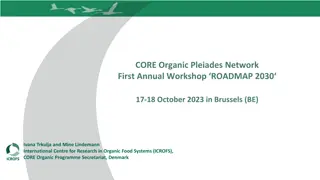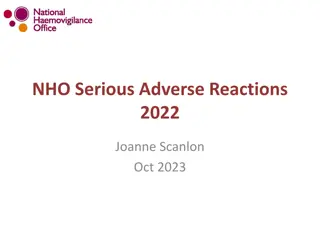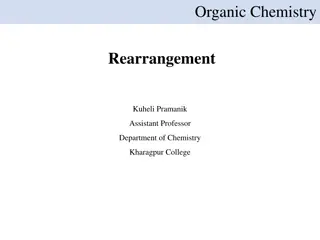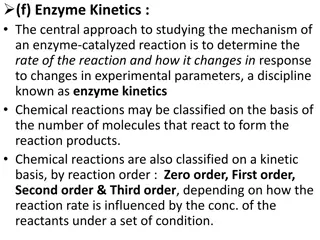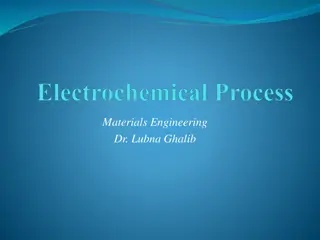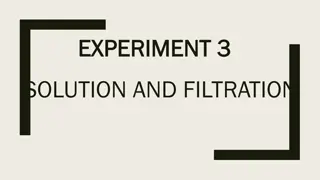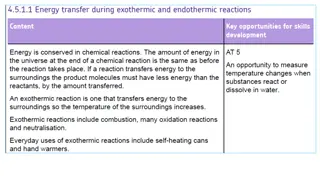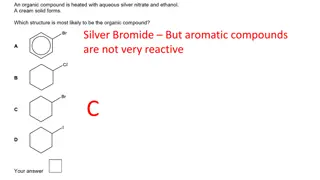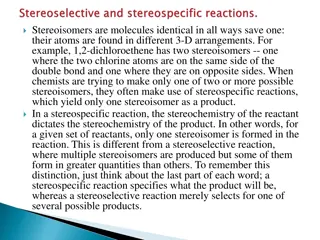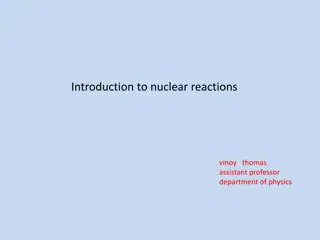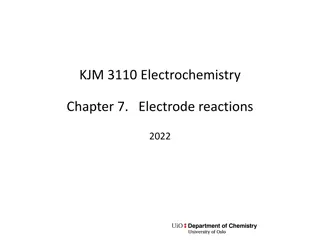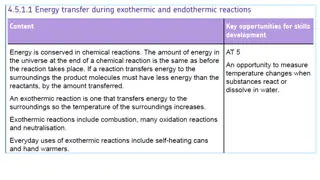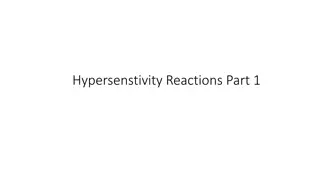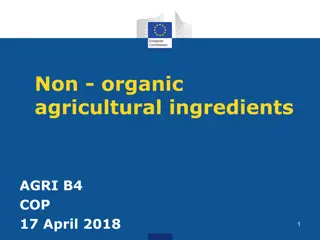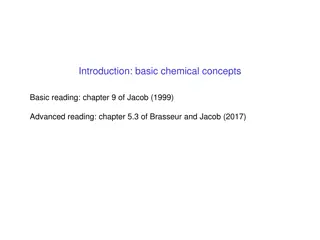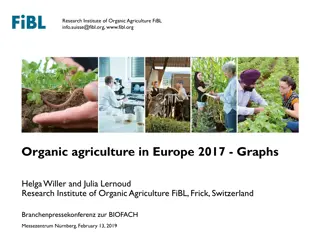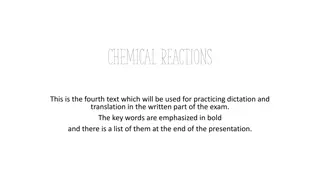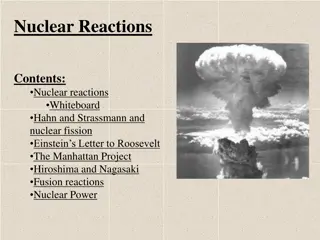Overview of Organic Reactions and Mechanisms
Organic reactions can be categorized into addition, elimination, and substitution reactions, occurring through either polar or free radical mechanisms. Polar reactions may be electrophilic or nucleophilic, while free radical reactions involve radicals reacting to complete electron octets. Different types of steps in reaction mechanisms include symmetrical and unsymmetrical bond formation or breakage. Additionally, nucleophilic substitution and addition reactions play crucial roles in rearranging molecule structures.
Download Presentation

Please find below an Image/Link to download the presentation.
The content on the website is provided AS IS for your information and personal use only. It may not be sold, licensed, or shared on other websites without obtaining consent from the author.If you encounter any issues during the download, it is possible that the publisher has removed the file from their server.
You are allowed to download the files provided on this website for personal or commercial use, subject to the condition that they are used lawfully. All files are the property of their respective owners.
The content on the website is provided AS IS for your information and personal use only. It may not be sold, licensed, or shared on other websites without obtaining consent from the author.
E N D
Presentation Transcript
Main classes of organic reactions Main organic reactions are: (i) addition reaction, (ii) elimination reaction and (iii) substitution reaction. All of these reactions may take place in either (i) polar mechanism, or through (ii) free radical mechanism. Polar reactions may be electrophilic or nucleophilic.
Types of Steps in Reaction Mechanisms Bond formation or breakage can be symmetrical or unsymetrical Symmetrical- homolytic Unsymmetrical- heterolytic
Free Radical Reactions Not as common as polar reactions Radicals react to complete electron octet of valence shell A radical can break a bond in another molecule and abstract a partner with an electron, giving substitution in the original molecule A radical can add to an alkene to give a new radical, causing an addition reaction
Steps in Radical Substitution Three types of steps Initiation homolytic formation of two reactive species with unpaired electrons Example formation of Cl atoms form Cl2 and light Propagation reaction with molecule to generate radical Example - reaction of chlorine atom with methane to give HCl and CH3. Termination combination of two radicals to form a stable product: CH3. + CH3. CH3CH3
Polar Reactions Molecules can contain local unsymmetrical electron distributions due to differences in electronegativities This causes a partial negative charge on an atom and a compensating partial positive charge on an adjacent atom The more electronegative atom has the greater electron density Elements such as O, F, N, Cl more electronegative than carbon
Nucleophilic Substitution Reaction Reaction Reaction Rearrangement reactions a molecule undergoes changes in the way its atoms are connected
Nucleophilic addition reactions: Electrophilic addition reactions:
Addition of Cl2 and Br2 carried out with either the pure reagents or in an inert solvent such as CH2Cl2 Br Br CH3CH=CHCH3 2-Butene Br2 CH3CH-CHCH3 2,3-Dibromobutane + CH2Cl2 addition of bromine or chlorine to a cycloalkene gives a trans-dihalocycloalkane Br Br Br2 + + CH2Cl2 Br Br Cyclohexene trans-1,2-Dibromocyclohexane (a racemic mixture) addition occurs with anti stereoselectivity; halogen atoms add from the opposite face of the double bond
Br2 CH3 CH3 CH3 CH3 CH3 CH3 H H H H Br Br Br H H Br R R S S racemic mixture Br CH3 CH3 CH3 CH3 H H Br2 H H H Br CH3 Br Br H CH3 S R meso
Addition of HX : Carried out with pure reagents or in a polar solvent such as acetic acid Addition is regioselective Br H H Br + + CH3CH=CH2 Propene HBr CH3CH-CH2 2-Bromopropane CH3CH-CH2 1-Bromopropane (not observed) slow, rate determining H + + Br + + H Br CH3CH=CHCH3 CH3CH-CHCH3 sec-Butyl cation (a 2 carbocation intermediate) Br fast + Br CH3CHCH2CH3 sec-Butyl cation (an electrophile) CH3CHCH2CH3 2-Bromobutane Bromide ion (a nucleophile) Markovnikov s rule: in the addition of HX, H2O, or ROH to an alkene, H adds to the carbon of the double bond having the greater number of hydrogens
On similar reduction other hydrocarbons are produced. CH2= CH2 +H2 Ethane CH3 CH= CH2 +H2 Propane CH3 CH= CH CH3 +H2 Butane
Addition of H2O addition of water is called hydration acid-catalyzed hydration of an alkene is regioselective; hydrogen adds preferentially to the less substituted carbon of the double bond HOH adds in accordance with Markovnikov s rule OH H H2SO4 + CH3CH=CH2 Propene H2O CH3CH-CH2 2-Propanol CH3 CH3 H2SO4 CH3C=CH2 H2O CH3C-CH2 + HO H 2-Methylpropene 2-Methyl-2-propanol
-Elimination: removal of atoms or groups of atoms from adjacent carbons to form a carbon-carbon double bond a type of -elimination called dehydrohalogenation (the elimination of HX)
Saytzeff rule: the major product of a elimination is the more stable (the more highly substituted) alkene Br CH3CH2O-Na+ CH3CH2OH + 2-Bromo-2- methylbutane 2-Methyl-2-butene (major product) 2-Methyl-1- butene Br CH3O-Na+ CH3OH + 1-Methyl- cyclopentene (major product) 1-Bromo-1-methyl- cyclopentane Methylene- cyclopentane
Substitution reactions parts from two molecules exchange Free Radical Substitution Reaction Electrophilic Substitution Reaction
Nucleophilic reactions: nucleophilic substitution (SN) Nucleophilic substitution: -> reagent is nucleophil -> nucleophil replaces leaving group -> competing reaction (elimination + rearrangements) leaving group nucleophilic substitution + X- Nu - C Nu + C X Nucleophile in the following general reaction, substitution takes place on an sp3 hybridized (tetrahedral) carbon tert-butyl alcohol tert-butyl bromide
Nucleophilic Substitution Some nucleophilic substitution reactions Nu - X- Reaction: + + CH3X CH3Nu HO - CH3-OH An alcohol RO - CH3-OR An ether HS - CH3-SH A thiol (a mercaptan) RS - CH3-SR A sulfide (a thioether) I - CH3-I An alkyl iodide + An alkylammonium ion CH3-NH3 NH3 + CH3-O-H An alcohol (after proton transfer) HOH H 21
SN1 reaction: unimolecular nucleophilic substitution SN1 is illustrated by the solvolysis of tert-butyl bromide Step 1: ionization of the C-X bond gives a carbocation intermediate Step 2: reaction of the carbocation (an electrophile) with aq. NaOH (a nucleophile) gives an alcohol
Step 2: reaction of the carbocation (an electrophile) with methanol (a nucleophile) gives an oxonium ion CH3 H3C CH3 H3C CH3 fast + + + O C C O + CH3O C OCH3 CH3 H3C H H H H H3C H3C CH3 CH3 Step 3: proton transfer completes the reaction H3C H3C CH3 H CH3 H + + O fast + C O O C O + H H3C H3C H3C CH3 H CH3 H3C C6H5 C6H5 C6H5 C6H5 -Cl- CH3OH -H+ + CH3O C C Cl C+ C OCH3 H H H H Cl Cl (R)-Enantiomer Cl Cl (S)-Enantiomer (R)-Enantiomer Planar carbocation (achiral) A racemic mixture
SN1 An energy diagram for an SN1 reaction 24
SN2 reaction: bimolecular nucleophilic substitution both reactants are involved in the transition state of the rate-determining step the nucleophile attacks the reactive center from the side opposite the leaving group H - H - H + + Br - HO C Br HO C Br HO C H H H H HH Transition state with simultaneous bond breaking and bond forming An energy diagram for an SN 2 reaction there is one transition state and no reactive intermediate


